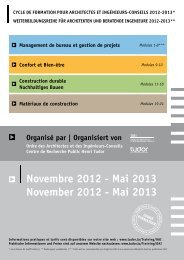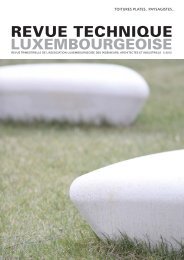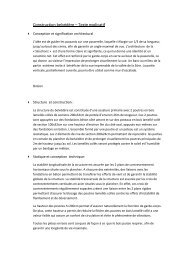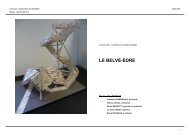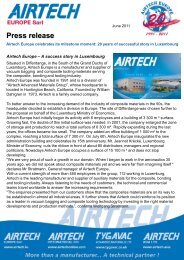Revue Technique Luxembourgeoise
Revue Technique Luxembourgeoise
Revue Technique Luxembourgeoise
You also want an ePaper? Increase the reach of your titles
YUMPU automatically turns print PDFs into web optimized ePapers that Google loves.
ARTICLES | REVUE TECHNIQUE LUXEMBOURGEOISE 3 | 2011 21<br />
© Andres Lejona<br />
bility, aesthetics, and green credentials and, like many other<br />
modified wood products, can be used in a range of applications<br />
– as explained above.<br />
Sustainability is increasingly important to not only the building<br />
and construction industry but also the general public.<br />
Consumer attitudes have changed in recent years – it is no<br />
longer deemed acceptable to use unsustainable and environmentally-damaging<br />
products or processes: an attitude<br />
which has ultimately had a positive impact on the industry<br />
in general, as it looks to satisfy these demands.<br />
Environmental stewardship is a hot topic, which lies at the<br />
top of the political agenda on a global level. In July 2010,<br />
the European Parliament voted to ban the import and sale<br />
of illegal timber into the EU – a major legislative step.<br />
Modified wood, and Kebony in particular, has been used by<br />
a number of leading international architects, builders and<br />
designers for some time. As such, others are increasingly<br />
beginning to see the quality, durability and viability of the<br />
product as word spreads and evidence grows for how well<br />
Kebony and other modified wood products perform. Kebony,<br />
in particular, increasingly experiences growing numbers<br />
of enquiries on a day-to-day basis with new clients<br />
and distributors announced on an international level (most<br />
recently, Brooks Bros in the UK).<br />
Kebony and sustainability – how contractors and architects<br />
are using modified wood products to make a<br />
play on their sustainability credentials<br />
Kebony and other modified wood products replace the use<br />
of endangered tropical timber and environmentally damaging<br />
toxic-treated woods.<br />
A global environmental awakening is one of the key drivers<br />
for contractors and architects choosing modified wood, as<br />
outlined above. In particular, by choosing Kebony, these firms<br />
can demonstrate the following sustainability credentials:<br />
_Kebony wood has a longer lifecycle than other wood,<br />
acting like a carbon ‘sink’ by locking in CO2 a lot longer<br />
than untreated wood.<br />
_Kebony has received several awards in recognition of<br />
its green approach – most recently named as one of the<br />
world’s most promising clean technology companies in the<br />
Global Cleantech 100. Kebony was also cited as one of the<br />
top 50 companies that could change our world in 2010 and<br />
one of the top 25 creative European Companies as well as<br />
receiving the Nordic region’s eco-label, the Swan, the Glass<br />
Bear for sustainable consumption and production and the<br />
Norwegian Blue Ocean Award.<br />
_Kebony is FSC-certified and is also embraced by leading<br />
preservation organisations such as The Rain Forest Coalition<br />
and the WWF.<br />
_Kebony was asked to present at the highly-acclaimed CC8<br />
Climate Conference and invited to display their innovative<br />
product at the UN-Climate Conference in Copenhagen.<br />
_Recent environmental studies also demonstrate that Kebony<br />
maple has a substantially lower carbon footprint than<br />
unsustainable Burmese teak.*<br />
www.kebony.com<br />
* A recent study by Norwegian environmental consulting firm Bergfald & Co<br />
demonstrated Kebony maple to be a suitable substitute for unsustainable<br />
Burmese teak in maritime and other applications, with a substantially lower<br />
carbon footprint.




